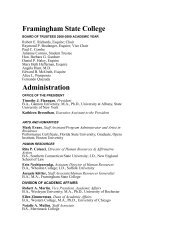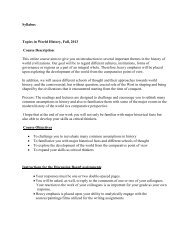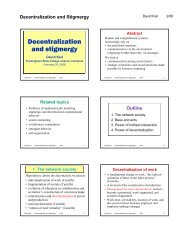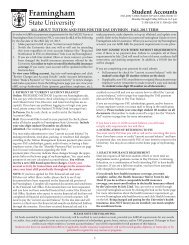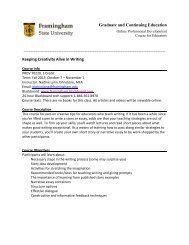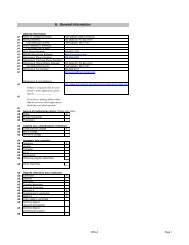Abstracts 2011 - Framingham State University
Abstracts 2011 - Framingham State University
Abstracts 2011 - Framingham State University
Create successful ePaper yourself
Turn your PDF publications into a flip-book with our unique Google optimized e-Paper software.
Billion Ao<br />
Heating and cooling rate of Morelia<br />
amethistina.<br />
Heating and cooling rates determine the time required to reach a preferred<br />
temperature range and the amount of time an organism can stay in that range. For<br />
majority of ectotherms, heating rate is higher than cooling rate to extend the amount of<br />
time within a preferred temperature range. Factors such as body size (kg) can<br />
influence these rates in predictable ways by manipulating surface area to volume<br />
ratios. Scrub pythons (Morelia amethistina), which are large tropical pythons, exhibit<br />
large body size variation from hatchling to adult. The goal of this experiment was to<br />
test if scrub pythons heated faster than cooled, and if their large change in body size<br />
affects these rates. The pythons (n=7) were heated and cooled in a hot (32.2 o C) and<br />
cold chambers (22.2 o C). Heating rate and cooling time constants (τ) of snakes were<br />
compared to operative models (n = 3), which were used to simulate the time constants<br />
of an inanimate object (i.e., an object without behavioral or physiological mechanisms).<br />
Heating rates of the scrub pythons (160 ± 76 min, mean ± SD) were significantly higher<br />
(p = 0.005) than cooling rates (229 ± 61 min, mean ± SD). The scrub pythons heated<br />
and cooled significantly slower (p = 0.03, p < 0.0001, respectively) than the operative<br />
models. Scrub pythons showed positive allometry in their heating tau (0.51) and<br />
negative allometry in their cooling tau (0.22) when compared to the predicted isometric<br />
scaling constant (0.33). Scrub pythons either physiologically or behaviorally regulate<br />
their heating and cooling rates. Morelia amethistina heated and cooled like many other<br />
ectotherms and show that as size increases heating and cooling rates slowed.<br />
Photographed by Dr. Dinkelacker<br />
Tau (min)<br />
350<br />
300<br />
250<br />
200<br />
150<br />
100<br />
50<br />
0<br />
Mean tau of scrub pythons and models<br />
*<br />
*<br />
Snake Heating Snake Cooling Model Heating Model Cooling<br />
*P-value < 0.01






